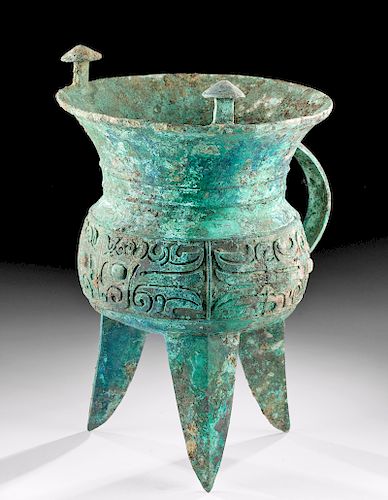Chinese Shang Dynasty Bronze Tripod Vessel - XRF Tested
Lot 133
About Seller
Artemis Gallery
686 S Taylor Ave, Ste 106
Louisville, CO 80027
United States
Selling antiquities, ancient and ethnographic art online since 1993, Artemis Gallery specializes in Classical Antiquities (Egyptian, Greek, Roman, Near Eastern), Asian, Pre-Columbian, African / Tribal / Oceanographic art. Our extensive inventory includes pottery, stone, metal, wood, glass and textil...Read more
Categories
Estimate:
$4,000 - $6,000
Absentee vs Live bid
Two ways to bid:
- Leave a max absentee bid and the platform will bid on your behalf up to your maximum bid during the live auction.
- Bid live during the auction and your bids will be submitted real-time to the auctioneer.
Bid Increments
| Price | Bid Increment |
|---|---|
| $0 | $25 |
| $300 | $50 |
| $1,000 | $100 |
| $2,000 | $250 |
| $5,000 | $500 |
| $10,000 | $1,000 |
| $20,000 | $2,500 |
| $50,000 | $5,000 |
| $100,000 | $10,000 |
| $200,000 | $20,000 |
About Auction
By Artemis Gallery
Sep 26, 2019
Set Reminder
2019-09-26 10:00:00
2019-09-26 10:00:00
America/New_York
Bidsquare
Bidsquare : Exceptional Day 1: Antiquities & Asian Art
https://www.bidsquare.com/auctions/artemis-gallery/exceptional-day-1-antiquities-asian-art-4437
Day 1 of an important 2-day auction featuring exceptional, museum-worthy examples of Egyptian, Greek, Etruscan, Roman, Viking, Russian, Near Eastern, as well as Asian Art from China, Japan, Thailand, Vietnam, Burma and India. Artemis Gallery info@artemisgallery.com
Day 1 of an important 2-day auction featuring exceptional, museum-worthy examples of Egyptian, Greek, Etruscan, Roman, Viking, Russian, Near Eastern, as well as Asian Art from China, Japan, Thailand, Vietnam, Burma and India. Artemis Gallery info@artemisgallery.com
- Lot Description
East Asia, China, Late Shang Dynasty, ca. 12th to 11th century BCE. A fascinating ritual wine vessel, a cast bronze "jia", a ritual wine vessel whose style originated in the Neolithic period in pottery form but came into its own with highly stylized form and decorative programs in the late Shang. The jia stands atop three long, flanged legs that flare outward slightly and end in delicate points. The rounded body has a corseted neck and a wide, deep mouth as well as a narrow strap handle that travels from the side of the neck to the lower body. Two roof-like projections rise from the mouth on the opposite side as the handle. A relief band around the body features repeated taotie masks with glaring bulbous "eyes" projecting outward from them. Size: 7" W x 9.8" H (17.8 cm x 24.9 cm)
The taotie is one of the "four fiends" or "four evil creatures" of Chinese mythology, and is a particularly fascinating and ancient symbol - seen on Shang Dynasty bronzes. In the Lushi Chunqiu, known in English as Master Lü's Spring and Autumn Annals, a Chinese encyclopedia compiled around 239 BCE, the taotie is described thusly: "The taotie on Zhou bronzes has a head but no body. When it eats people, it does not swallow them, but harms them" (16/3a Prophecy). This and other ancient descriptions of the creature suggest that it related to making food offerings/sacrifices for the insatiable spirits of the dead. Some scholars believe that the creature is part of the mysterious communication between people and the gods.
This vessel would have been placed into a tomb as an offering, and represents the early stages of mass produced Chinese pottery in state-controlled workshops - a technological advancement that would characterize Chinese material culture for the next millennia and more. The low-fired glaze was made using lead, so it is for the best that it was meant for a grave rather than use in life!
This piece has been tested for the presence or absence of particular elements via XRF elemental analysis. A basic 1-page summary of the XRF screening will accompany purchase, identifying each element present in the sample, as well as the quantity of elements present. A more complete analysis detailing historical data / comparisons is available for additional charge – please contact us.
Provenance: private Ventura County, California, USA collection
All items legal to buy/sell under U.S. Statute covering cultural patrimony Code 2600, CHAPTER 14, and are guaranteed to be as described or your money back.
A Certificate of Authenticity will accompany all winning bids.
We ship worldwide and handle all shipping in-house for your convenience.
#148100Excellent condition with mottled turquoise patina and nice deposits on surface. Motifs are very clear. One of the legs may have been repaired but if so it is incredibly well done and difficult to discern.Condition
- Shipping Info
-
All shipping is handled in-house for your convenience. Your invoice from Artemis Gallery will include shipping calculation instructions. If in doubt, please inquire BEFORE bidding for estimated shipping costs for individual items.
-
- Buyer's Premium



 EUR
EUR CAD
CAD AUD
AUD GBP
GBP MXN
MXN HKD
HKD CNY
CNY MYR
MYR SEK
SEK SGD
SGD CHF
CHF THB
THB
















